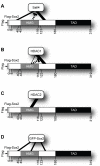Sox2 uses multiple domains to associate with proteins present in Sox2-protein complexes
- PMID: 21103394
- PMCID: PMC2980493
- DOI: 10.1371/journal.pone.0015486
Sox2 uses multiple domains to associate with proteins present in Sox2-protein complexes
Abstract
Master regulators, such as Sox2, Oct4 and Nanog, control complex gene networks necessary for the self-renewal and pluripotency of embryonic stem cells (ESC). These master regulators associate with co-activators and co-repressors to precisely control their gene targets. Recent studies using proteomic analysis have identified a large, diverse group of co-activators and co-repressors that associate with master regulators, including Sox2. In this report, we examined the size distribution of nuclear protein complexes containing Sox2 and its associated proteins HDAC1, Sall4 and Lin28. Interestingly, we determined that Sox2 and HDAC1 associate with protein complexes that vary greatly in size; whereas, Lin28 primarily associates with smaller complexes, and Sall4 primarily associates with larger complexes. Additionally, we examined the domains of Sox2 necessary to mediate its association with its partner proteins Sall4, HDAC1 and HDAC2. We determined that Sox2 uses multiple and distinct domains to associate with its partner proteins. We also examined the domains of Sox2 necessary to mediate its self-association, and we determined that Sox2 self-association is mediated through multiple domains. Collectively, these studies provide novel insights into how Sox2 is able to associate with a wide array of nuclear proteins that control gene transcription.
Conflict of interest statement
Figures






Similar articles
-
Proteomic analysis of Sox2-associated proteins during early stages of mouse embryonic stem cell differentiation identifies Sox21 as a novel regulator of stem cell fate.Stem Cells. 2010 Oct;28(10):1715-27. doi: 10.1002/stem.494. Stem Cells. 2010. PMID: 20687156 Free PMC article.
-
Determination of protein interactome of transcription factor Sox2 in embryonic stem cells engineered for inducible expression of four reprogramming factors.J Biol Chem. 2012 Mar 30;287(14):11384-97. doi: 10.1074/jbc.M111.320143. Epub 2012 Feb 9. J Biol Chem. 2012. PMID: 22334693 Free PMC article.
-
Differential HDAC1 and 2 Recruitment by Members of the MIER Family.PLoS One. 2017 Jan 3;12(1):e0169338. doi: 10.1371/journal.pone.0169338. eCollection 2017. PLoS One. 2017. PMID: 28046085 Free PMC article.
-
Crosstalks between Raf-kinase inhibitor protein and cancer stem cell transcription factors (Oct4, KLF4, Sox2, Nanog).Tumour Biol. 2017 Apr;39(4):1010428317692253. doi: 10.1177/1010428317692253. Tumour Biol. 2017. PMID: 28378634 Review.
-
Networks of Transcription Factors for Oct4 Expression in Mice.DNA Cell Biol. 2017 Sep;36(9):725-736. doi: 10.1089/dna.2017.3780. Epub 2017 Jul 21. DNA Cell Biol. 2017. PMID: 28731785 Review.
Cited by
-
SOX2-LIN28/let-7 pathway regulates proliferation and neurogenesis in neural precursors.Proc Natl Acad Sci U S A. 2013 Aug 6;110(32):E3017-26. doi: 10.1073/pnas.1220176110. Epub 2013 Jul 24. Proc Natl Acad Sci U S A. 2013. PMID: 23884650 Free PMC article.
-
Exogenous LIN28 Is Required for the Maintenance of Self-Renewal and Pluripotency in Presumptive Porcine-Induced Pluripotent Stem Cells.Front Cell Dev Biol. 2021 Jul 20;9:709286. doi: 10.3389/fcell.2021.709286. eCollection 2021. Front Cell Dev Biol. 2021. PMID: 34354993 Free PMC article.
-
The dark side of SOX2: cancer - a comprehensive overview.Oncotarget. 2017 Jul 4;8(27):44917-44943. doi: 10.18632/oncotarget.16570. Oncotarget. 2017. PMID: 28388544 Free PMC article. Review.
-
R-loops coordinate with SOX2 in regulating reprogramming to pluripotency.Sci Adv. 2020 Jun 10;6(24):eaba0777. doi: 10.1126/sciadv.aba0777. eCollection 2020 Jun. Sci Adv. 2020. PMID: 32704541 Free PMC article.
-
Mechanisms of Drug Resistance in Ovarian Cancer and Associated Gene Targets.Cancers (Basel). 2022 Dec 18;14(24):6246. doi: 10.3390/cancers14246246. Cancers (Basel). 2022. PMID: 36551731 Free PMC article. Review.
References
-
- Nichols J, Zevnik B, Anastassiadis K, Niwa H, Klewe-Nebenius D, et al. Formation of pluripotent stem cells in the mammalian embryo depends on the POU transcription factor Oct4. Cell. 1998;95(3):379–91. - PubMed
-
- Chambers I, Colby D, Robertson M, Nichols J, Lee S, et al. Functional expression cloning of Nanog, a pluripotency sustaining factor in embryonic stem cells. Cell. 2003;113(5):643–55. - PubMed
Publication types
MeSH terms
Substances
Grants and funding
LinkOut - more resources
Full Text Sources
Research Materials
Miscellaneous

